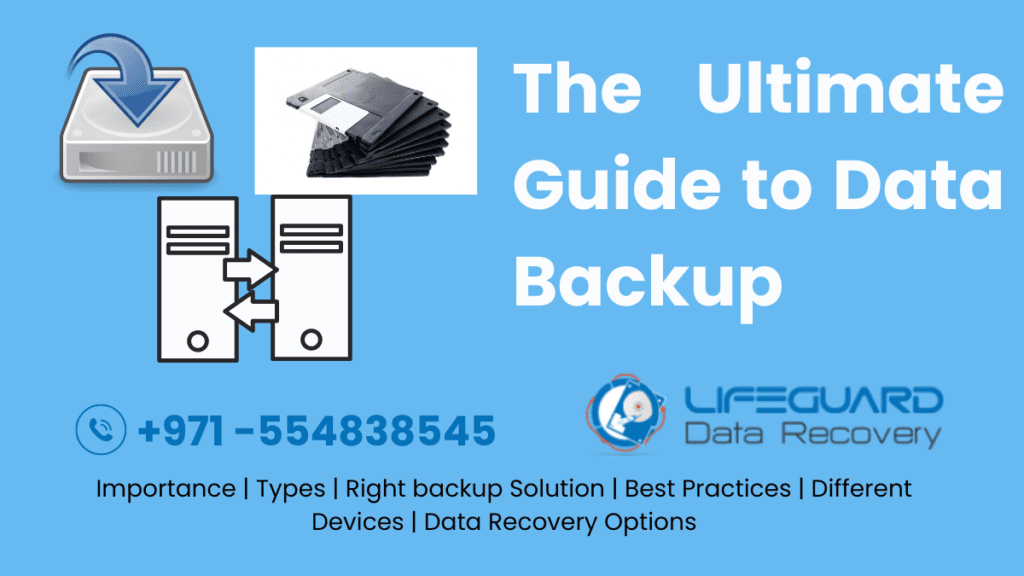In today’s digital age, our lives revolve around technology and our valuable data. From precious memories stored in photos and videos to important documents and business files, the data we accumulate is invaluable. That’s why it’s essential to have a robust data backup strategy in place, ensuring the safety and security of your digital world.
In “The Ultimate Guide to Data Backup,” we will explore everything you need to know about protecting your data from unexpected loss or damage. Whether you’re a business owner, a frequent traveler, or simply someone who wants peace of mind, this comprehensive guide will be your go-to resource.
Discover the different backup methods available, including cloud storage, external hard drives, and network-attached storage (NAS). Learn about the importance of encryption and password security to safeguard your sensitive information. Understand the best practices for scheduling backups, so you never have to worry about losing your data.
Don’t let a hardware failure, cyber attack, or accidental deletion leave you in a panic. Follow our expert advice and ensure the longevity and resilience of your digital world with effective data backup solutions.
The importance of data backup
Data backup is more than just a precautionary measure; it is a necessity in our technology-driven lives. Imagine losing all your precious photos, important documents, or years of hard work due to a hardware failure or a cyber attack. The consequences could be devastating. Data backup provides a safety net for your digital assets, ensuring that even if the worst-case scenario occurs, you can quickly recover and restore your data.
One of the primary reasons for data loss is hardware failure. Hard drives can crash, and devices can become damaged or stolen. Additionally, malicious software, viruses, and cyber attacks can result in data corruption or loss. By regularly backing up your data, you create an additional copy that can be easily accessed and restored to its original state.
Types of data backup
When it comes to data backup, there are various methods and technologies available. Each has its advantages and considerations, depending on your needs and preferences.
- Cloud storage: Cloud storage has gained popularity due to its convenience and accessibility. Services like Dropbox, Google Drive, and iCloud allow you to store your data remotely on secure servers. Cloud storage offers automatic syncing across devices and the ability to access your files from anywhere with an internet connection.
- External hard drives: External hard drives provide a physical backup solution that you can connect to your computer or device. They offer large storage capacities and can be easily transported. However, they require manual backups and are vulnerable to physical damage or theft.
- Network-attached storage (NAS): NAS devices are like personal cloud storage solutions. They are connected to your home or office network, allowing multiple devices to access and backup data. NAS provides greater control over your data and enables continuous backups for added convenience.
Choosing the right backup method depends on factors such as the size of your data, level of security required, accessibility needs, and budget constraints. It is often recommended to have multiple backup solutions to ensure redundancy and protect against different risks.
Manual vs. automated data backup
When it comes to data backup, automation is key to ensure consistency and minimize the risk of human error. Manual backups are prone to forgetfulness and inconsistency, making them less reliable. Automated backup solutions, on the other hand, can be scheduled to run at specific intervals or triggered by specific events, such as connecting to a specific network or plugging in an external hard drive.
Automated backups provide peace of mind, as they require minimal effort on your part once set up. They ensure that your data is regularly backed up without you having to remember to do it manually. Additionally, automated backups can often run in the background, minimizing disruption to your workflow.
Choosing the right data backup solution
With numerous data backup solutions available, choosing the right one can be overwhelming. Here are some key considerations to help you make an informed decision:
- Storage capacity: Assess your data storage needs and choose a solution that offers enough space to accommodate your current and future data requirements. Consider factors such as the number of devices you want to back up and the types of files you regularly work with.
- Security: Data security is crucial, especially when storing sensitive information. Look for backup solutions that offer robust encryption and password protection to ensure the confidentiality of your data. Additionally, consider whether the solution complies with relevant data protection regulations.
- Accessibility: Consider how easily you can access your backed-up data. Cloud storage solutions offer the advantage of being accessible from any device with an internet connection. External hard drives and NAS devices, on the other hand, provide physical access to your data but require you to be in proximity to the storage device.
- Scalability: Choose a backup solution that can grow with your needs. As your data volume increases, you may require additional storage capacity. Ensure that the solution allows for easy expansion or upgrading without significant disruption or cost.
- Reliability: Research the reputation and reliability of the backup solution provider. Look for user reviews and ratings to gauge the experiences of others. A reliable backup solution should have a track record of data protection and recovery.
By considering these factors, you can make an informed decision and choose a data backup solution that meets your specific needs.
Best practices for data backup
Having a data backup solution is not enough; implementing best practices ensures the effectiveness and reliability of your backup strategy. Here are some key practices to follow:
- Regular backups: Set a regular backup schedule based on the frequency of data changes and your tolerance for potential data loss. For critical data, daily backups may be necessary, while less frequently updated data can be backed up weekly or monthly.
- Versioning: Enable versioning if your backup solution supports it. Versioning allows you to keep multiple versions of a file, enabling you to revert to a previous version if needed. This can be particularly useful in cases where you accidentally overwrite or delete important data.
- Offsite backups: Consider storing a copy of your backups offsite. This protects against physical damage or theft of your primary storage and ensures that your data is safe even in the event of a disaster.
- Testing backups: Regularly test the restoration process to ensure that your backups are working correctly. Simply having backups is not enough; you need to be confident in your ability to recover your data when needed.
- Monitoring: Regularly monitor your backup system for any errors, failures, or inconsistencies. Automated notifications or alerts can help you stay informed and take corrective action promptly.
By following these best practices, you can optimize the reliability and effectiveness of your data backup strategy.
Data Backup for Different Devices and Platforms
Mobile Devices
In today’s world, our smartphones have become an extension of ourselves. We capture countless photos and videos, store important documents, and even conduct business transactions all from the palm of our hand. It’s crucial to have a backup plan in place to protect this valuable data.
One of the easiest and most convenient methods is to utilize cloud storage services. Both Android and iOS devices offer built-in options such as Google Drive and iCloud, respectively. These services provide seamless integration, allowing you to automatically backup your data to the cloud. Additionally, they offer the flexibility to access your files from any device with an internet connection.
If you prefer to have more control over your backups, external hard drives can be a viable option. By connecting your mobile device to a computer, you can manually transfer and store your data on an external drive. This method offers an extra layer of security, as you physically possess the backup, reducing the risk of unauthorized access.
Another consideration is the use of dedicated backup apps. These apps often provide additional features such as scheduled backups, selective file syncing, and encrypted storage. Popular options include Carbonite, Acronis True Image, and Backblaze Mobile.
Computers
Computers are the heart of our digital lives, containing vast amounts of personal and professional data. Whether you’re using a Windows PC or a Mac, there are several backup methods available to ensure the safety of your files.
Cloud storage is an increasingly popular choice for computer backups. Services like Dropbox, Google Drive, and Microsoft OneDrive offer seamless integration into your operating system, allowing you to automatically sync and backup your files. This ensures that your data is protected and accessible from anywhere with an internet connection.
If you prefer to have physical control over your backups, external hard drives are a reliable option. These portable drives can be connected to your computer via USB or Thunderbolt ports, providing a quick and easy way to backup your files. Some external drives even come with software that allows for automated backups at scheduled intervals.
For those with more demanding storage needs, network-attached storage (NAS) devices can be an excellent solution. NAS devices are essentially dedicated file servers that connect to your home or office network. They offer large storage capacities and can be accessed by multiple devices simultaneously. NAS devices often come with built-in backup software, allowing you to schedule automatic backups and protect your data from hardware failures.
Cloud Storage
Cloud storage has revolutionized the way we backup and access our data. By storing files on remote servers maintained by service providers, you can ensure the safety and security of your valuable information.
One of the primary advantages of cloud storage is its accessibility. Whether you’re using a computer, smartphone, or tablet, you can access your files from anywhere with an internet connection. This flexibility is especially useful when travelling or working remotely.
Most cloud storage services offer a range of pricing options, allowing you to choose a plan that suits your storage needs and budget. Free options like Google Drive and Dropbox offer a limited amount of storage, while paid plans provide larger capacities and additional features.
When selecting a cloud storage provider, it’s crucial to consider security measures. Look for services that offer end-to-end encryption, which ensures that your files are encrypted both during transmission and while at rest on the server. Additionally, strong password security and two-factor authentication should be implemented to prevent unauthorized access.
Data Recovery Options
Despite our best efforts, there may come a time when data loss occurs. Whether it’s due to hardware failure, accidental deletion, or a cyber attack, having a plan for data recovery is essential.
Local Backups
If you’ve followed best practices and have a local backup strategy in place, recovering your data can be relatively straightforward. Simply connect your backup device, whether it’s an external hard drive or NAS, and restore your files using the backup software or File Explorer.
It’s important to remember not to overwrite your existing data when performing a recovery. Ensure that you’re restoring your files to a different location or device to avoid further data loss.
Cloud Backups
If you’ve utilized cloud storage as your backup method, recovering your data is often as simple as logging into your account and downloading the files you need. Most cloud storage services offer intuitive interfaces that allow you to browse your files and select specific items for recovery.
In the event of a catastrophic failure or loss of your primary device, cloud storage can be a lifesaver. By accessing your files from a different device, you can quickly restore your data and resume normal operations.
Data Recovery Services
In some cases, data loss may be more severe, such as when a hard drive fails or becomes physically damaged. In these situations, it may be necessary to seek professional help from data recovery services.
Data recovery services specialize in retrieving data from damaged or corrupted storage devices. They have the necessary tools and expertise to recover your files, even in the most challenging circumstances. However, these services can be costly, and there’s no guarantee of a successful recovery.
It’s important to weigh the value of your data against the cost of professional recovery services. If the data is critical and irreplaceable, seeking professional help may be worth the investment. Otherwise, exploring other recovery options should be considered.
At LifeGuard Data Recovery, we have a 30+ years of recovering data from various devices through out UAE, Kenya and India.
Conclusion: Protecting Your Digital Assets
In today’s digital world, our data is more vulnerable than ever. From hardware failures to cyber attacks, there are countless threats that can result in data loss. That’s why it’s crucial to have a comprehensive data backup strategy in place.
By understanding the different backup methods available for various devices and platforms, you can ensure the safety and security of your digital assets. Whether you choose cloud storage, external hard drives, or network-attached storage, remember to prioritize encryption and password security to safeguard your sensitive information.
Regularly scheduling backups is another crucial aspect of data protection. By automating the process, you can ensure that your files are always up to date and easily recoverable in the event of data loss.
Finally, it’s essential to have a plan for data recovery in case the worst happens. Whether it’s utilizing local backups, cloud storage, or seeking professional help, having a recovery strategy will minimize the impact of data loss and allow you to resume normal operations quickly.
Don’t wait until it’s too late. Take the necessary steps to protect your digital world today, and enjoy peace of mind knowing that your valuable data is safe and secure.





















